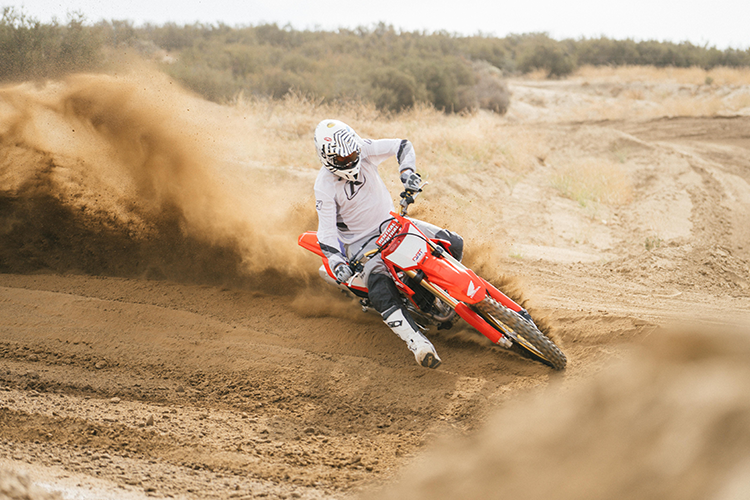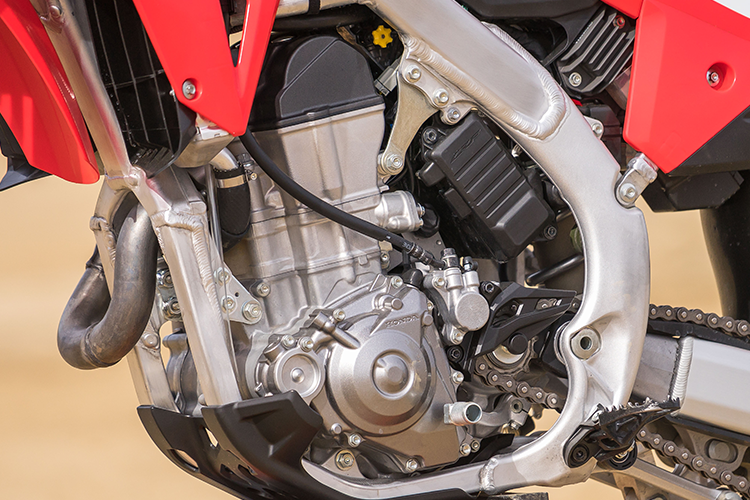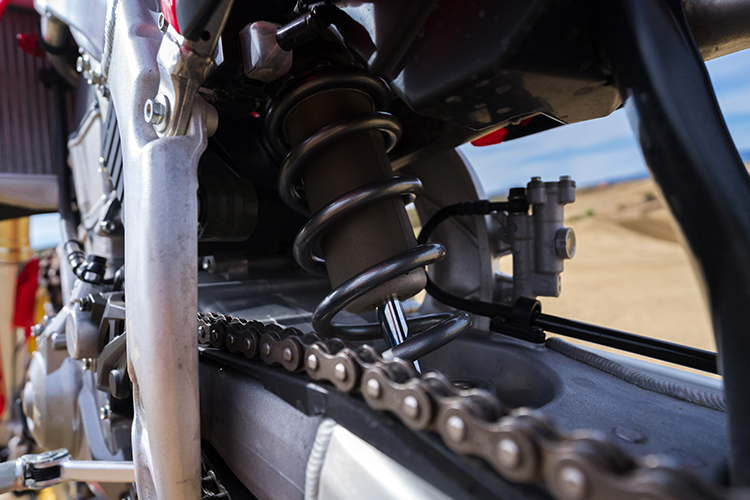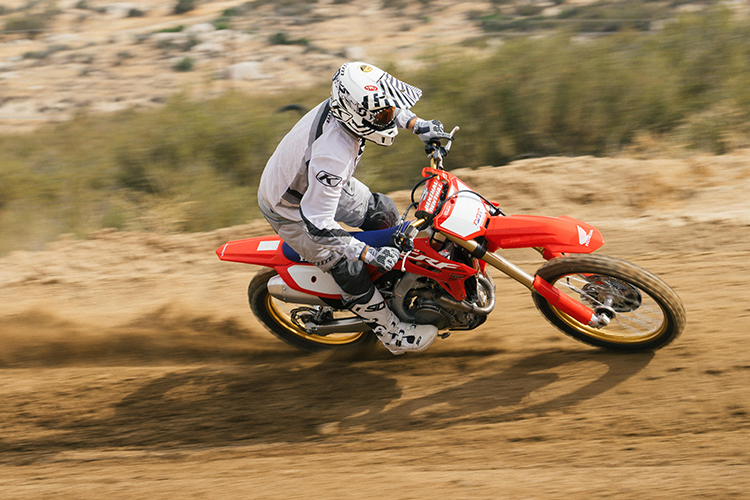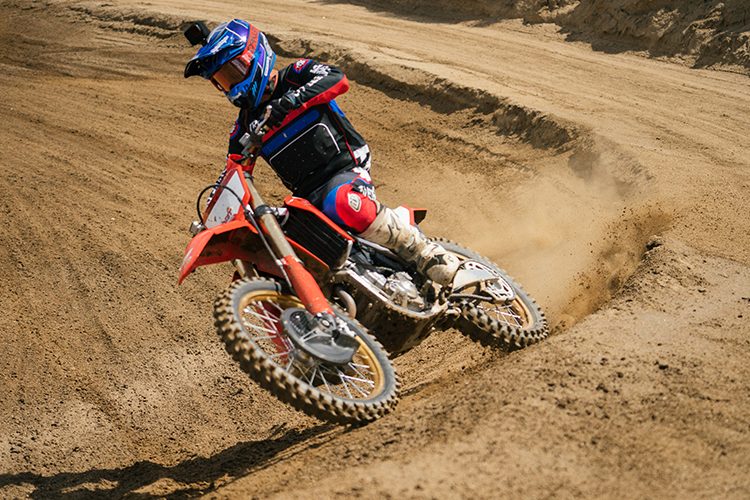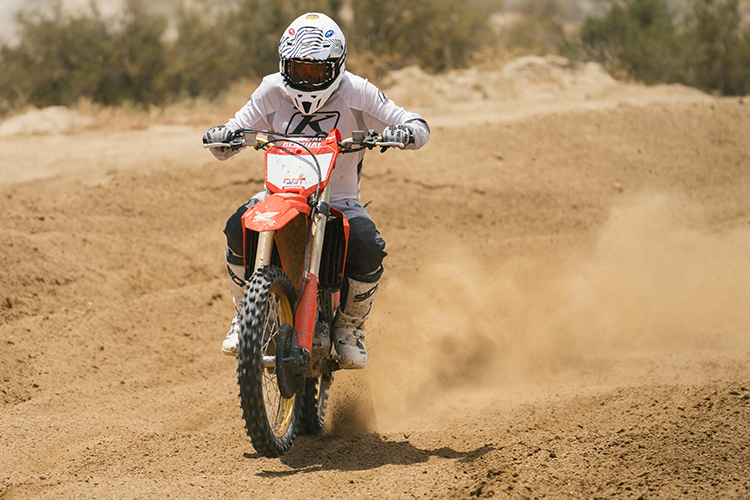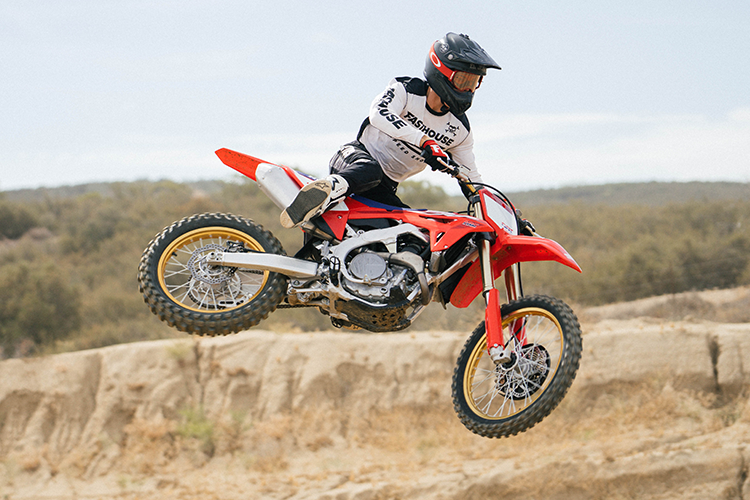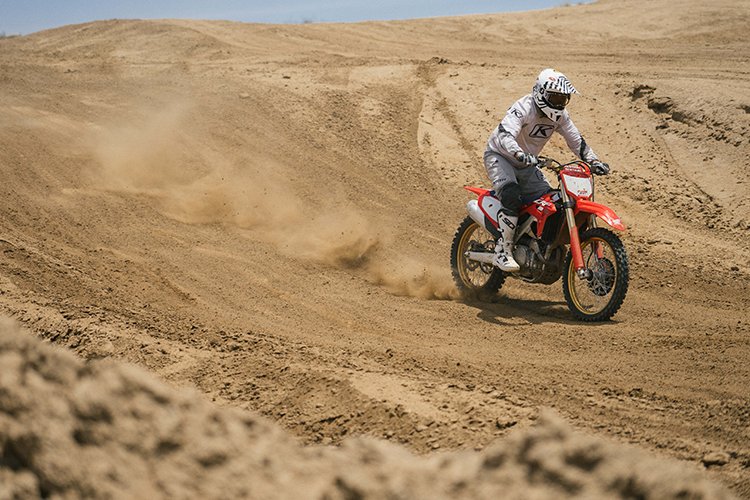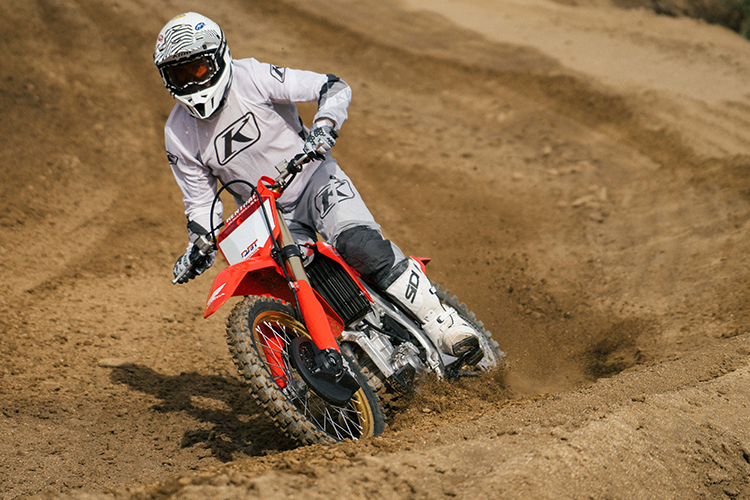Do Looks Equate To Performance?
Story by Jimmy Lewis, Photos by Trevor Hunter
We spent a day on the 2023 Honda CRF450R 50th Anniversary Edition at Cahuilla Creek Motocross Park, in California, for a quick riding impression. We’ll cut right past the fact that everyone we spoke to loved the look of this bike, whether they knew the history of the colors, or not. If you want to learn a little about this, watch HERE. We are not, however, looking at the bike while we’re riding and if you know us, the looks don’t factor in once the bike is off the stand.
We had four riders of varying skill levels, from a total novice MX rider, to an old senior expert, to some off-road Pros all spin laps on both the main and vet tracks. In doing so, we gathered as much feedback as possible in one single day. Like most of the new bikes these days, there are very few faults. But all bikes have a different character, and we’ll get into that here.
Straight away, if you have been off a CRF450R since before 2021, you have a big step to take in order to catch up. Compared to the last generation, the whole bike is smoothed over and given some aggression at the same time. If you are coming from another brand, we’d be correct in saying that every manufacturer pays attention to what Honda does with the CRF so they can react. There is a lot of “Yardstick Performance” in the CRF that is used to measure where every other model lineup stands. Other bikes can easily outperform in individual categories, but for most riders the red bike shines as a package. So much so that the CRF, in spite of its 450cc of fury, sometimes gets described as being somewhat “vanilla.”
For 2023, Honda refined plenty of things, starting with the engine. It starts with a slightly smaller throttle body, includes a new intake shape and utilizes a new cam to give more torque without losing much, if any, power on top. For the record, Honda’s have always been fairly horsepower laden, but the torque numbers didn’t match, and riders felt this on the track. Now it feels like there is much more power driving you forward. Especially at the lower RPMs, it pulls harder and has more snap but is never too snappy-only in the standard map.*****
Once a rider activates one of the two additional maps, one more mellow and one more aggressive, they are rewarded with exactly what they’ve asked for: The smooth map adds traction control (and there is additional traction control mapping available through the handlebar mounted switch-we’ll get to that next) and a delivery that our novice rider favored. The aggressive map used to be the go-to map all the time for most of our faster and heavier riders but now most of us stayed with standard. Now the aggressive map is reserved for excellent traction or sand, where you want wheel spin on tap via a spicy power delivery. It can be a handful and we applaud Honda for having the guts to give riders the maps they are asking for as a standard feature. When in the aggressive map, a few of our riders felt it necessary to ride taller gears, be smooth on the throttle, and finesse the bike more than in the standard map.
The traction control features three levels in addition to each map and it too works. Some riders love this while others will never touch it, but we tried it out and were impressed. Specifically, adding traction control to the aggressive map, getting nutty with the throttle and letting the computer do the work. Since it is sensing the rate of RPM increase, as opposed to actual wheel speed sensing, it does have some flaws. But riders found sweet combos once they learned the buttons.
On to the buttons: this is the biggest gripe we have with the CRF. You need to have the bike at idle RPM in order to make changes, and for the ignition maps it requires a three-second hold of the button. Try counting three seconds while coasting on or next to a track! Apparently designed to force the rider to pull over and take the time to do this, one can only assume that this system was designed by the safety department and endorsed by the legal department, intentionally to make it utterly useless for changing the maps on the fly like we all want. The maps work and we want to use more than one during a moto, please Honda?
We feel the stock gearing was spot on for the track and shifting and clutching was as solid as we have come to expect. The hydraulic clutch is a little different feeling when compared to those of the Austrian brands. For some, the actuation has less feel, or a very consistent feel, depending on how one would describe it. Either way, it was very fluid feeling and provided excellent action, regardless of whether the rider liked the linear engagement or lack of a precise point of resistance at the lever.
The muffler has been altered to be a little more durable and a bit quieter. To the naked ear, when spectating trackside, it is quieter but the rider still gets a sound that excites.
So, in short, the engine is improved with power everywhere. It is fast, smooth, controllable and fun. We like it.
On to the chassis, and the “Red Riders” have been tuning the aluminum frame to get the rigidity just right. This goes hand in hand with the suspension as well. Between tweaks to material type (engine hangers) and material thickness (front frame joint and shock tower) they have made it feel as if they increased the spring rate by two rates. Yet they haven’t. They did increase the rear spring rate though. What you have now is a CRF that is balanced and has less pitching, yet does not get stiffer feeling in a negative way. Unless you were our pickiest rider who felt the “slapdown” (front end returning to the ground, not in the best way) on jump landings was on the harsh side. Honda suggested and we agree that the handlebar is stiffer than most and accounts for a large portion of this feeling as clicks in suspension did little to nothing.
The chassis is good on all accounts, with a precision that is generally praised because it is so good. Too good, for those that do not prefer it; too precise, if that can be a thing. The bike feels light for a 450, but it isn’t skittery. If anything, the new chassis and suspension combine effectively to make the bike feel planted, without being too stiff on the smaller bumps. Clicks on the suspension, especially the compression adjuster on the fork and the high-speed compression adjuster on the shock, affected the turning of the bike more than anything, and was easily carried out to suit the rider’s style. We settled on 105mm of sag for all of our riders and no one had any issues.
These are some of the best feeling Showa components we have tested. They have a very KYB plushness at the beginning of the stroke which is a huge improvement from the past. They still have the bottoming resistance that we like. It seems that riders notice the suspension on the CRF more than other bikes and our experience is that the bike is a little pickier track to track. We feel that most will like the tires and have found that they too have a profound effect on the bike’s handling, as a whole.
Simply put this bike works as good as it looks, and that is a win. You can get a standard edition for $300 less and it will work exactly the same. These days all the 450s are awesome, you just have to find the one that fits your needs the best. This CRF has a very wide catch net.
Do You Like DBT Bringing You Fresh Content? Search and Shop Through the Links Above or Below:

